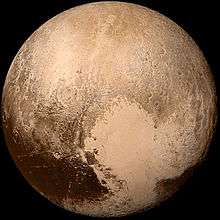2013 GP136
| Designations | |
|---|---|
| MPC designation | 2013 GP136 |
| TNO, sednoid | |
| Orbital characteristics[1] | |
| Epoch JD 2457400.5 (2016-Jan-13.0) | |
| Observation arc | 717 days |
| Aphelion | 263.8736 AU |
| Perihelion | 41.1201 AU |
| 152.4968 AU | |
| Eccentricity | 0.73035 |
| 1870 years | |
| 355.92184 | |
| Inclination | 33.50041 |
| 210.71728 | |
| 42.15634 | |
|
| |
2013 GP136 is a planetoid in the outer reaches of the Solar System.
It was mentioned in a paper 2016 by Malhotra of the Lunar and Planetary Laboratory, at The University of Arizona, Tucson, AZ as a detached object with a perihelion greater than 40 AUs, and a 6:1 orbital period ratio with Sedna, and in a possible 9:1 Mean-motion resonance with a hypothetical large Planet Nine.[2]
See also
Notes
References
- "MPEC 2015-R47 : 2013 GP136". IAU Minor Planet Center. 2016-03-19. Retrieved 2016-03-19.
External links
- Orbital simulation from JPL (Java) / Horizons Ephemeris
- 2013 GP136 Inner Oort Cloud Object Discovery Images from Scott S. Sheppard/Carnegie Institution for Science.
- 2013 GP136 at the JPL Small-Body Database

This article is issued from Wikipedia - version of the 8/2/2016. The text is available under the Creative Commons Attribution/Share Alike but additional terms may apply for the media files.
_(cropped).jpg)
